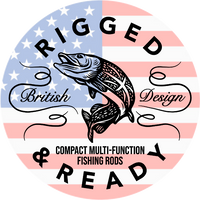How to String a Fishing Pole Step-by-Step for Beginners

Most fishing rods don’t really come ready to cast. And it's very much inciting the fishing experience: how to put line on a fishing pole, but if anything goes wrong, the fishing experience becomes quite dull.
From the local lake to backcountry Bass fishing to setting up something extremely compact like a Rigged and Ready Fish rig 180, here lies the actual how-to guide on how to line a fishing pole in a few steps to get you out fishing faster, less tangled more confident.
Why String It Correctly Anyway?
You might be thinking: How is it that proper line rigging separates smooth casts from talcum bird nests?
If your fishing rod is not threaded properly, the fisherman will experience tangled lines, poor casting, or even it might appear as though the rod is twisting the line in the air. This is a common mistake-many of us have been guilty of it at one time or another. It is a step-by-step guide, in case you are threading your rod for the very first assist or just want to make sure you are doing it right.
Also Read: Fishing Hook Sizes
What You Need
That's all you will need to get started:
• A rod and reel combo of any kind.
• Spinning or baitcasting
• The fishing line: monofilament, fluorocarbon, or braid.
• Scissors or line clippers
Step-by-Step: How to String a Fishing Pole
Here are bite-sized steps to follow on how to line a fishing pole, even if this is the first time your fingers have ever grasped one.
Step 1: Pick the Right Line
Take a good look at your line. It's gotta' be in good condition and with the appropriate breaking strain.
• Monofilament: lines are supple, soft, floating, and easy to work with. Best for novices.
• Fluorocarbon: sinks, virtually invisible underwater, and a little stronger.
• Braid Line: it's the strongest and the thinnest, good for fishing near the cover, but tough for the newbies.
Look on the spool on your reel; it will tell you how much line it can hold-you are on to the next stage of learning how to set up a fishing pole.
Step 2: Set the Reel on the Rod
Unscrew the reel seat on the handle.
Slide the reel foot into position.
Make sure it is tight enough to move.
Doesn't matter what kind of fishing rod you've got from a heavyweight rig to some fine travel rod like the Fish rig 180, do not skip this step: make sure everything is snug before you learn how to line fishing pole with problems during the middle of the cast.

Step 3: Open the Bail Arm (Fixed Spool) or Release the Clutch (Baitcaster)
If you have a fixed spool reel, you open the bail arm (it is a wire arm on the reel) which releases the line off the spool.
Release that clutch if it's a baitcaster (also called the thumb bar).
Another very important tip is to ensure that the line is running through the level of wind guide. That's how to set up a fishing pole before going out. If you miss it, you've only got half an hour to untangle those knots with a pocketknife.
Step 4: Free the End of the Line
There usually is a clip or a rubber band holding the end of the line on most spools. Just try to find it and pull it gently. If you pull too hard, you might as well have lost a roll of toilet paper in the wind tunnel.
You want just enough slack to work with—there's no need to let out 100 yards of line flailing about in your living room.
Step 5: Close Bail Arm and Have Reel on Free Running (If Applicable)
Now, when the line is let's say, loose, you wanna close that bail arm up (or actually turn the clutch back on a baitcaster). If your reel features free-running mode, pop it in there. It is gonna let the line come off nice and smooth as you run the line through the rod without the spool spinning like a blender.
Step 6: Thread the Line Through the Rings
Now the fun begins, threading the line.
Taking it from the first ring close to the reel down through everyone all the way up to the tip of the rod. Take your time with this one. If you miss one, you'll only realize after tying everything else together, and that's a perfect recipe for well, muttering cursing.
This one is a place where you don't want to rush when learning how to set up a fishing pole.
Triple-check each guide. Worth it.
Also Read: Best Lures for River Fishing
Bonus tips for newbie fingers
Check your guides: they can damage the line—really.
• Keep slight tension: Apply light tension between your fingertips while spooling the reel to keep the line from forming loops.
• Avoid twists: The line must come off the spool in the direction of the reel rotation.
• Start simple: If you are learning how to line a fishing pole, monofilament is what you want.
Learn to tie either a better clinch or Palomar knot---good ones. Strong and easy to do.
Free running can be a fantastic mode on a gusty day. It helps keep your line from being snared in anything from your shoe to your dog's fur.
Wrapping Up: You are Now Ready to Fish
That's all! You now know how to string a fishing pole. You can try out fishing now, after learning how do you string a fishing rod and threading down the guides-and of course avoiding the infamous missed-eyelet mishap.
With such a small step, you will be an extra mile further toward a bent rod and a big ear-to-ear grin whether you are casting from a dock or just preparing to go walk along some riverbanks with Fishrig 180.
Get out there and wet a few lines-chart yourself a tug that is far more exciting than a limb.





